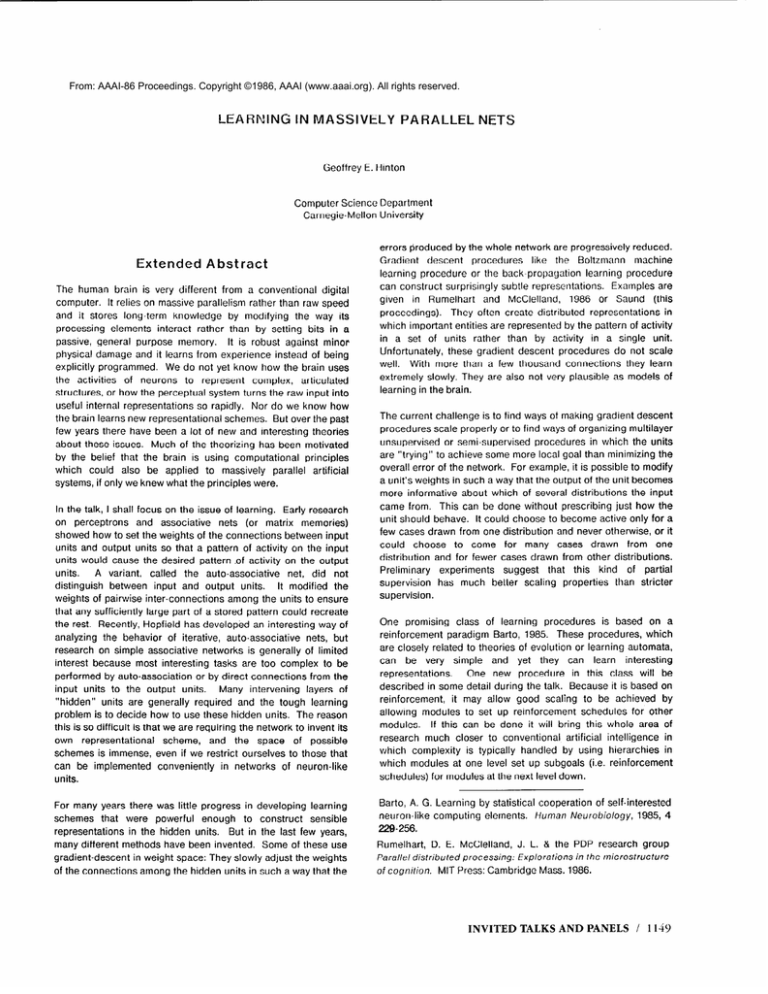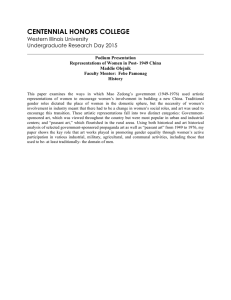
From: AAAI-86 Proceedings. Copyright ©1986, AAAI (www.aaai.org). All rights reserved.
LEARNING
IN IMASSIVELY
PARALLEL
NETS
Geoffrey E. t linton
Computer Science Department
Carnegie-Mellon University
Extended
errors produced by the whole network are progressively
Gradient
descent
procedures
like the Boltzmann
Abstract
learning
The human
computer.
brain
is very different
from a conventional
It relies on massive parallelism
and it stores
long-term
knowledge
digital
rather than raw speed
by modifying
the way
its
processing elements interact rather than by setting bits in a
passive, general purpose memory.
It is robust against minor
physical damage and it learns from experience instead of being
explicitly programmed.
We do not yet know how the brain uses
the activities
of neurons to represent
complex,
articulated
structures, or how the perceptual system turns the raw input into
useful internal representations
so rapidly. Nor do we know how
the brain learns new representational
schemes. But over the past
few years there have been a lot of new and interesting theories
about these issues. Much of the theorizing has been motivated
by the belief that the brain is using computational
principles
which could also be applied to massively
parallel
systems, if only we knew what the principles were.
artificial
In the talk, I shall focus on the issue of learning.
Early research
on perceptrons
and associative
nets (or matrix memories)
showed how to set the weights of the connections between input
units and output units so that a pattern of activity on the input
units would cause the desired pattern .of activity on the output
units.
A variant, called the auto-associative
net, did not
distinguish
between input and output units.
It modified the
weights of pairwise inter-connections
among the units to ensure
that any sufficiently large part of a stored pattern could recreate
the rest. Recently, Hopfield has developed an interesting way of
analyzing the behavior of iterative, auto-associative
nets, but
research on simple associative networks is generally of limited
procedure
or the back-propagation
learning
reduced.
machine
procedure
can construct surprisingly subtle representations.
Examples are
given in Rumelhart
and McClelland,
1986 or Saund (this
proceedings).
They often create distributed representations
in
which important entities are represented by the pattern of activity
in a set of units rather than by activity in a single unit.
Unfortunately,
these gradient descent procedures do not scale
well. With more than a few thousand connections
they learn
extremely slowly. They are also not very plausible
learning in the brain.
as models of
The current challenge is to find ways of making gradient descent
procedures scale properly or to find ways of organizing multilayer
unsupervised or semi-supervised
procedures in which the units
are “trying” to achieve some more local goal than minimizing the
overall error of the network. For example, it is possible to modify
a unit’s weights in such a way that the output of the unit becomes
more informative about which of several distributions the input
came from. This can be done without prescribing just how the
unit should behave. It could choose to become active only for a
few cases drawn from one distribution and never otherwise, or it
could choose to come for many cases drawn from one
distribution and for fewer cases drawn from other distributions.
Preliminary
experiments
suggest
that this kind of partial
supervision
has much belter scaling properties
than stricter
supervision.
One promising class of learning procedures
is based on a
reinforcement
paradigm Bar-to, 1985. These procedures, which
interest because most interesting tasks are too complex to be
performed by auto-association
or by direct connections from the
input units to the output units.
Many intervening
layers of
“hidden” units are generally required and the tough learning
problem is to decide how to use these hidden units. The reason
this is so difficult is that we are requiring the network to invent its
own representational
scheme,
and the space of possible
schemes is immense, even if we restrict ourselves to those that
are ctosety related to theories of evolution or learning automata,
can be very simple and yet they can learn interesting
representations.
One new procedure
in this class will be
described in some detail during the talk. Because it is based on
reinforcement,
it may allow good scaling to be achieved by
allowing modules to set up reinforcement
schedules for other
modules.
If this can be done it will bring this whole area of
research much closer to conventional
artificial intelligence
in
which complexity
is typically handled by using hierarchies in
can be implemented
units.
which modules at one level set up subgoals (i.e. reinforcement
schedules) for modules at the next level down.
conveniently
in networks
of neuron-like
For many years there was little progress in developing
schemes that were powerful
enough to construct
representations
many different
in the hidden
units.
But in the last few years,
methods have been invented.
gradient-descent
of the connections
learning
sensible
Some of these use
in weight space: They slowly adjust the weights
among the hidden units in such a way that the
Barto, A. G. Learning by statistical cooperation of self-interested
neuron-like computing elements, Human Neurobiology,
1985, 4
a-256.
Rumelhart,
Parallel
D. E. McClelland,
distributed
of cognition.
processing:
J. L. & the PDP research
Explorations
MIT Press: Cambridge
INVITED
group
in the microstructure
Mass. 1986.
TALKS AND PANELS
/ 1149









